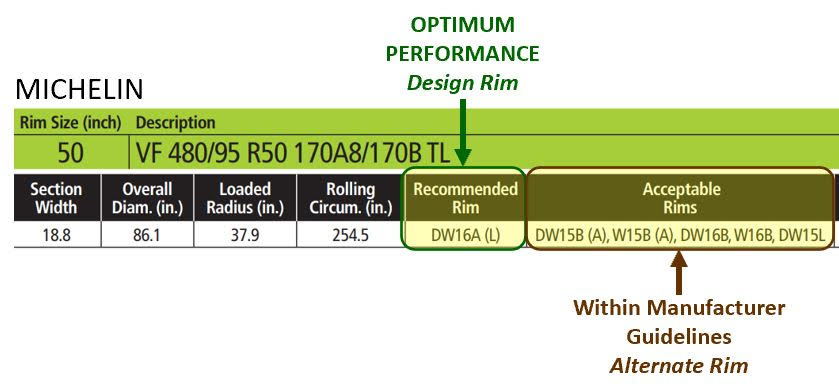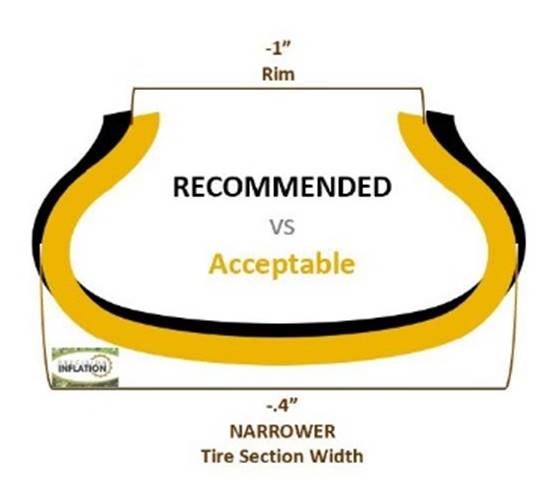Editor’s Note: This Q&A originally appeared in AG Tire Talk to provide answers that farm equipment dealers have about farm tire technology. This series features a trending question followed by an abridged version of the answers. For the complete answers, check out www.agtiretalk.com.
AG Tire Talk Key Takeaways
YOKOHAMA: Recommended wheel widths are very important, when it comes to getting all that you have paid for in a tire. Sure, you may use a narrower or secondary recommendation. Unfortunately, you could lose a variety of benefits and may not even know it.
MICHELIN: I highly recommend using the recommended wheels, as this will ultimately result in increased traction, better flotation, reduced soil compaction, improved fuel efficiency and even longer tread life.
CONTINENTAL: Changing or modifying the rim width, along with the flange height, would affect the tire performance, since the deflection area in the sidewall will change. A change in the deflection area on the sidewall will have an impact on the ground contact area, affecting mainly traction and flotation.
PRECISION INFLATION: When Tire is mounted on alternate 15 inch rim, TIRE SECTION WIDTH (1” x 40% ) = 0.4” NARROWER vs. Design 16 inch rim.
MAXAM: For any farmer or grower, selecting the right wheel and tire combination will maximize his equipment’s performance by optimizing his load carrying capability while delivering the necessary power to plow, plant, harvest, or spray his crops.
TRELLEBORG: A conventional 480/80R50 tire has a recommended rim size of 15 inch (15 x 50 inch) but when referring to the VF 480/80R50 tire, the recommended rim size is 16 inch wide rim (16 x 50 inch). There is one exception to this rule and that is when the IF or VF tire is marked as NRO (Narrow Rim Option) version, then the VF tire can use the same rim size as the conventional tire.
BKT: The bead package in the IF/VF version is heavier and the DW wheel makes mounting easier with less chance of damaging the bead of the tire. The wider wheel allows the IF/VF technology to work to its potential.
Nick Phillippi: National Product Manager, Yokohama Off-Highway Tires America
“Rims” normally refers to the outside rolled metal, and a “wheel” is a rim with the center installed, either welded or mechanically.
Most rim widths are set by TRA standards and follow a rule for the overall width of the tire. But because IF and VF tires “squat” further and that outward pressure under loads puts more stress and “pull” on the bead areas, if and VF rim fitments are normally always one size larger — 1 to 2 inches — than a standard tire or the same width.
Follow the manufacturers guidelines shown in the load/inflation charts, as in the illustration. Using the optimum-sized rim means your tires will deliver their optimum footprint and last longer.
Recommended wheel widths are very important, when it comes to getting all that you have paid for in a tire. Sure, you may use a narrower or secondary recommendation. Unfortunately, you could lose a variety of benefits and may not even know it.
David Graden, Operational Market Manager – Agriculture, Michelin Ag
Back when Michelin invented the first Ultraflex (IF/VF) tires, they were based upon research that showed changing the flex point in the sidewall of the tire actually elongated and widened the footprint. As a direct result, we have seen with IF/VF increased traction, better flotation, reduced soil compaction, improved fuel efficiency and even longer tread life.

On IF/VF tires, we didn’t simply change the load/inflation tables. In fact, we changed the core design of the casing. By reducing the amount of rubber in some places and adding rubber to others, we caused the sidewall to naturally flex at a different point than standard tires, while maintaining a very flat footprint. As a result, we typically recommend a slightly wider wheel for these tires to optimize performance, as this wider footprint could add varying degrees of additional strain to the bead area of the tire. Also, the wider recommended wheel provides the maximum footprint, as this is the wheel the tire was designed and tested on, as shown below:
To be clear, recommended rim always optimizes traction and flotation; however, all acceptable rims listed by the manufacturer will provide adequate performance and will meet requirements of all warranties.
I highly recommend using the recommended wheels, as this will ultimately result in increased traction, better flotation, reduced soil compaction, improved fuel efficiency and even longer tread life. It will give you a lower total cost of ownership and add more to your bottom line.
Ken Brodbeck, VP of Technology, Precision Inflation LLC
Does Rim Width Matter?
The short answer is yes.
Design Rim Width is listed in both the Tire and Rim Year Book and by individual tire manufacturers. They may or may not agree with each other. Your best choice is to check each manufacturer’s data book or website for their design and alternate rim widths.

Definitions
Design Rim: is the Rim Width that the tire is designed to and molded at the factory for Optimum Performance.
*It is important to note that often a tire manufacturer will call out a wider rim for an IF or VF tire compared to the standard size tire.
Alternate Rim: is an alternate to the design rim. Not the engineer’s first choice, but still a rim that the manufacturer will warrant for the tire size in question and will provide satisfactory performance.
What happens if I choose the Approved Alternate Rim Width?
- Alternate Rims cause the Tire Section Width to WIDEN or NARROW by 40% for each 1” of Rim Width Change.
Example: VF 480/80R50
- Design Rim (Recommended) is 16” / Alternate Rim (Acceptable) is 15”.
- When Tire is mounted on Alternate 15” Rim, TIRE SECTION WIDTH (1” x 40% ) = 0.4” NARROWER vs Design 16” Rim.
- Alternate rims typically have a minor impact on tread radius, traction and flotation. And I will defer to the tire manufacturer’s comments on these parameters.
- Choosing a rim that is neither design or alternate now pushes a tire into a configuration that can significantly alter the tire’s performance including creating irregular wear and durability issues that the manufacture may not cover under warranty.
- NOT RECOMMENDED
Bottom line: If you are starting out with a new tire on any machine, your best choice is to select the design rim.
Second choice is the approved manufacturer’s alternate rim found in their data book or website.
Lastly, any rim outside design or alternate will likely cause you problems and could lead to the tire coming out of service prematurely along with voiding the tire’s warranty.
Harm-Hendrik Lange, Customer Solutions Engineer for Continental Commercial Specialty Tires (CST), Continental Agriculture North America
Changing or modifying the rim width, along with the flange height, would affect the tire performance, since the deflection area in the sidewall will change. A change in the deflection area on the sidewall will have an impact on the ground contact area, affecting mainly traction and flotation. Also, a different rim width could have an impact on the mounting process, increasing the stress in the bead area.
These factors can also help in finding the best tire-rim combination:
- Most tire producers recommend a specific rim width for a specific tire dimension marked with bold letters. With this rim width, the tire has its optimal performance.
- In most cases, technical data is also related to the recommended rim width.
- If the operator plans to use a wider or narrower rim than recommended, the resulting tire section width can be estimated roughly by a 10mm change of the tire section width per inch rim width. For example: The tire can be used with 15, 16 and 18 inch rim width according to the data book, but data is based on a 16 inch rim. The user wants to combine the tire with an 18” rim and asks himself if the tire still has enough free space to the vehicle chassis. He needs to add 20mm to the tire section width when using 18 inch instead of the 16 inch rim.
Greg W. Gilland, Business Development & Ag Segment Manager, Maxam Tire International
All Agricultural tires either of radial or bias conventional construction are designed by size to fit on a certain rim seat. Depending on the equipment design or need, rims also are made in various widths to allow the tire under load to drive or steer the vehicle and provide the best load carrying capability.
In the last article of Ag Tire Talk we reviewed that radial tire construction accounts for 20% of the carcass load or pressure on the soil, while the compressed air in the tire chamber accounts for 80% of the carrying capacity. Therefore the key to a tire successfully carrying the load and delivering the expected performance is the capability of the air in the tire to suspend the load and allow the tire sidewall deflection or “Tire Bulge” under a given load to push the tire footprint to deliver the rim pull or torque to move in the desired direction.
By convention and industry agreement, tires must conform to international standards to be of a certain geometry or tire size.
Norberto Herbener, OE Applications Engineer, Trelleborg Wheel Systems
When talking agricultural tires, each tire manufacturer makes recommendations for an ideal rim width in addition to two additional size options to give operating flexibility (a narrower and wider tire sizes). This recommended rim width is calculated by using standardized formulas agreed by all tire manufacturers within TRA (Tire and Rim Association) and ETRTO (Europe Tire and Rim Technical Organization).
The selection of the rim width influences the total width of the tire – the wider the rim, the wider the tire (specially on the sidewall area and not on the tread width). Staying with our 480/80R50 tire, for example:
- Using a 14 inch rim it would decrease to 475 mm (18.7 inch)
- Using the recommended 15 inch rim the total tire width would be at 485 mm (19.1 inch)
- Using a 16 inch rim it would increase to 495 mm (19.5 inch)
These values are always measured at nominal air pressure. Changing between tire manufacturer permitted rim sizes will not affect the rest of the tire specifications and capabilities. The change in tire total width would have a minimal impact on tire traction and flotation. These parameters are largely influenced by inflation pressure and the load the tire is carrying.
Dave Paulk, Manager Field Technical Services, BKT USA Inc.
All wheel rims should be selected based on the tire manufacturer’s recommended and alternate options for the specific tire being used. The Tire and Rim Association lists both Design Rim (Recommended Rim) & Approved Rim (Alternate Rim) widths and contours for agricultural tires.
A tire’s recommended rim width identifies option tire was designed to. In contrast, alternate rim width identifies acceptable options on which the tire can be mounted and provide adequate performance.
Each rim width generally works with only a few tire widths. The flange contour is also important for mounting and bead seating. Some examples of contours are W, DW, F, and L.
Using a rim wider than listed manufacturer options flattens the tread face and the stability of the tractor is affected. In hard soil, there is less lug penetration and less traction. Stress is then concentrated in the shoulder area and increases the amount of shoulder tread wear. When the tire’s beads are mounted farther apart than intended, it forces the sidewall of the tire to flex in an area lower than normal. This creates circumferential carcass breaks and sidewall separations. We do not suggest going outside listed manufacturer parameters for any reason.
Using a narrower rim than listed manufacturer options can cause mounting problems and impede the bead from seating properly to the wheel. Increased pressure from the bead to the rim flange can cause possible bead and sidewall separation to the tire and premature rim failure. The tread of the tire is rounded (like an overinflated tire), and tread wear is concentrated in the center of the tire. Therefore, traction in the field is greatly reduced. We do not suggest going outside listed manufacturer parameters for any reason.
Related Content
How to Check Ag Track Alignment






